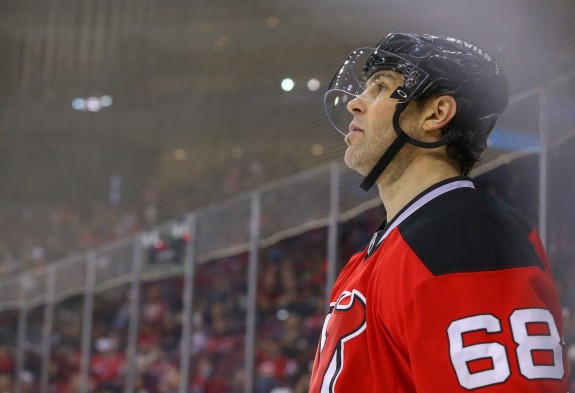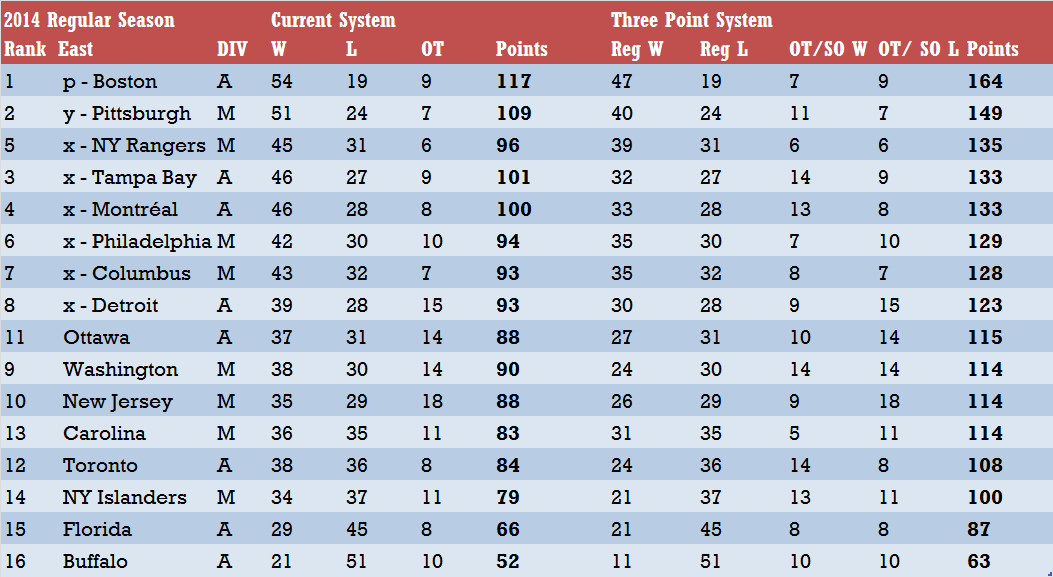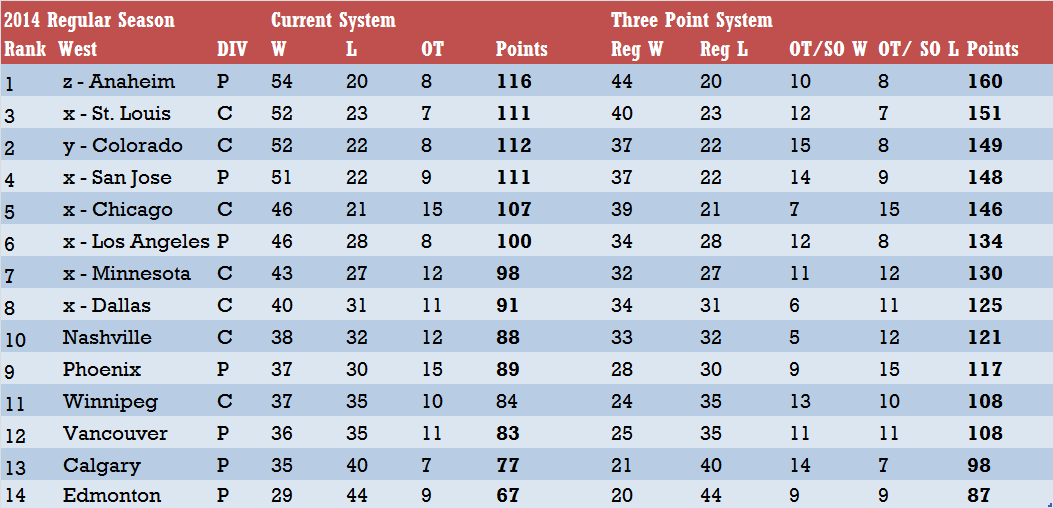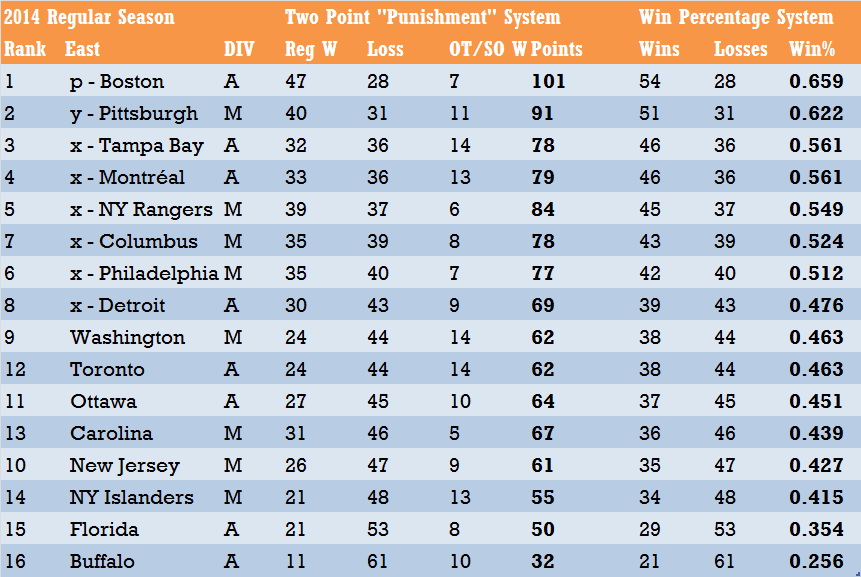
Three Point System (3-2-1-0)
It is no secret that fans and media alike do not enjoy the current NHL point system. Many argue that a three-point system would increase a teams “desire to win in regulation.” This may indeed be true as it would punish teams for not finishing games in regulation and their chances of dropping back in the standings even with a win in overtime could increase. For those of you not familiar with the proposed three-point system it breaks down as such;
- A regulation win is worth 3 points.
- An overtime or shootout win is worth 2 points.
- An overtime or shootout loss is worth 1 point.
- A regulation loss is worth 0 points.
What this system addresses is the problem with the current system awarding an additional point for overtime games. Currently two points are awarded for games that end in regulation, to the winner. But if a game ends in overtime or a shootout three points are awarded, two to the winner and one to the loser. Overtime games in the current system are more valuable than games that end in sixty minutes because of this “loser point.” This extra point allows teams to stay in playoff hunts despite losing games throughout the year. Even the new tiebreaker rule discrediting shootout wins has not been used in an actual scenario yet. It appears that the current point system is not only flawed but completely broken.
Appearances Can Be Deceiving
In spite of the problems the current point system has, the proposed three-point system would change absolutely nothing. Unlike numerous other media outlets that use incomplete data to make their assertions I took the time to compare the complete 82-game season from 2014 and contrast it with the three-point system. The result is nearly a mirror image of how every team finished last season.


Meager Changes
Under the three-point system the exact same sixteen teams would have made the playoffs in 2014. On top of that six out of eight playoff match-ups would have gone unchanged. No team moved more than two positions in the standings and the margin of those changes is minimal. Not only does the three-point system not affect playoff teams, but it also has a limited effect on teams who finish at the bottom of the standings. The differences in this system compared to the current system are not just minute, they are microscopic. This is no coincidence either, fellow THW writer Josh Smith addressed this topic before and found that all sixteen teams from 2012 would still have made the playoffs under a three-point system.
Through conclusive evidence that factors in the entirety of the data without excluding games yet to be played, it is quite obvious that a three-point system will do nothing except justify the elimination of the loser point and replace it with the most superficial of all things, more points. A three-point system would have 246 possible points compared to 164 under the current system which is a drastic change. It’s just a marketing tool that wouldn’t mean anything except numerous broken records without those teams truly being better than the true record holders. Nothing would have been solved or accomplished under the false pretense of, “at least overtime games are no longer worth more value.”
Alternatives
So what are some alternative solutions? The shocking fact about the three-point system is that it will probably never happen due to its obvious pitfalls. On top of that, it has overshadowed some alternatives that in hindsight solve the “loser point” issue without creating other problems. Regrettably, due to the allure of “more points” these ideas rarely amass any demand among fans or the media. I myself had not even heard much about these alternative options until now because of the cloud of fabrication that the three point system has cast upon all of us.
Option #1 Bring Back Ties
This is the most well known surrogate outside the three point system since it is simply a revisit to hockey before the 2005 lockout. The NHL actually utilized three separate point systems with ties through its history. Each version eliminates the loser point and rewards teams for finishing games in regulation. Of course these systems were around before the shootout was enacted in 2006. A rebirth of the tie would also mean the death of the shootout at least in these versions. On top of that, fans are not exactly overjoyed at the thought of ties anymore. The tie systems break down as such;
- Pre-1983 NHL- No Overtime. 2 points for a win. 1 point for a tie. 0 points for a loss.
- 1984-1999 NHL- 5 minute Overtime introduced. 2 points for a win. 1 point for a tie. 0 points for a loss in regulation or overtime.
- 2000- 2004 NHL- 5 minute Overtime. 2 points for a win. 1 point for a tie or an overtime loss. 0 points for a regulation loss.


Consequently much like the three-point system, the old tie systems also would not affect the current point system in any drastic way. Depending on which version you look at there is slighty more differences in the standings. The New Jersey Devils and Nashville Predators would have squeaked their way into the playoffs under the right circumstances. Personally going back to ties would not be the end of the world but for the most part people want to see a winner even if it requires a shootout. Ties can be entertaining, but more times than not seeing one team get a victory is more satisfying. The first ever NHL game that I saw live was in 1997 between the Anaheim Ducks and San Jose Sharks and it ended in a 5-5 tie. It was exciting, hard-hitting and something that I will never forget but I was disappointed that of all things it ended in a tie. This is why most people do not like to hear about anything besides the three-point system because ties are simply not popular and it is understandable.
Option #2 Punish the Loser
I first became aware of this idea thanks to an article by John Fantana on Raw Charge, a Tampa Bay Lightning website. The overall idea behind it is to remove the “loser point” but also punish teams for making it to overtime in the first place. Agree or disagree this concept is innovative and should be given a lot more credit. The two point “punishment” system is very similar to the three-point system in how it operates because fewer points are given to the winner of an overtime game. In 2014, the New York Rangers only went past regulation 12 times while the Washington Capitals did a whopping 28 times! One reason why this solution probably does not gain much popularity is because it would lead to a decrease in points. Under the punishment system teams will be rewarded for finishing games in regulation and punished for going beyond sixty minutes. The “punishment” system breaks down as such;
- A regulation win is worth 2 points.
- An overtime or shootout win is worth 1 point.
- A loss in any fashion is worth 0 points.
Option #3 Winning Percentage
A very simple and very obvious solution the NHL point system could take is to simply eliminate points altogether. Of course the only way this can work is if the league is willing to accept the fact that there is a bona fide winner and loser. This means that a shootout loss would be completely equal to a regulation or overtime loss. If fans, media and hockey personalities alike are willing to accept this it would be the easiest system to follow. The only thing that is holding us back is pride, our own satisfaction and our unwillingness to change. Treating all wins and all losses equally here is a breakdown of the “punishment” system and the winning percentage system;


Answers?
Something that many of you may be wondering is why the standings through so many point system variations are barely effected. The reason is because each system relies on WINS first and everything else as a secondary point counter. As a result of each system treating wins the same it doesn’t allow for much diversity. In my opinion using win percentages could very well be the best option but it is very hard to let go of past generations and simple tradition. In general, that is the core issue for all of these proposed alterations. To put it simply;
The overall “feel” would be drastic while the actual impact would be paltry.
Ultimately, the true problem with the current point system isn’t so much the “loser” point but the shootout itself. Extending overtime, or creating 3v3 play can help to alleviate the issue. A fourth option is the implementation of playoff style overtime where a win must be decided regardless of how long it takes. The odds of it ever happening are remote but it sure would solve the problem if this were a perfect world. Less shootouts will lead to less discontent with the current system but we should not delude ourselves into thinking there are superior point systems. The same teams will make the playoffs and the same teams will miss the playoffs regardless of what point system is in place. With this in mind we can interpret this in two separate ways.
- If the other systems have no real impact on standings then why bother changing the point system?
- If the other systems are so similar then is it not all the more reason to change it simply to eliminate the “loser” point?
Those are the facts folks, choose your side.
I think you’ve missed a key element in your analysis. Teams fighting for playoff spots may in fact change tactical play (be more offensive in their approach) in close games under these rules. So statistical analyses of date from the past as almost useless. The temptation of that extra point may do all kinds of things to coaching decisions late down the stretch. i.e. pull the goalie 5 x 5 late in games, or simply press heavy on the attack where previously they may play more defensive to “get the game to OT” so they guarantee a point. Why not create more drama and excitement for fans?
This is idiotic. There are meager changes, but there are changes none the less. Your single sample to show that there would be no changes in fact does show that there have been changes under the three point system.
Ummmm… 6 of 8 playoffs series would have remained unchanged?? Try again. With the 2 teams that changed position, they play a different opponent… meaning that their former opponents would also have different opponents, meaning half, 4 of 8, playoff series would have been different. I’ll break it down so there is no confusion.
In the East, NYR played MTL and TB played PHI. with the 3 point system, those would have been reversed: NYR plays PHI and TB and MTL play each other.
In the West, COL and MIN played, STL and LA played. With the 3 point system MIN would have played STL and LA and COL would have tangled.
I agree with the other comments that it would change the style of play in the last half of the 3rd period, but interesting analysis none the less. I would be interested to see it simulated over the past couple years. I don’t think that anyone was expecting half the time that missed the playoffs to suddenly make it, but its very tiring to look at the standings and 2/3 of the teams, if not more, appear to have winning records.
Because of quasi-divisional playoff pairings there would be no changes in the East. The only change in the West is flipping STL and COL for #1/#2 in the Central.
In my ideal world, the shootout would be eliminated and we would have 2pts for a reg win or OT (5×5 10min OT with the long change) win and 1pt apiece if tied after OT. However, that’s a utopian thought because the NHL loves their shootout gimmick and their loser point and there are many, NHL execs and fans alike, who do not want ties to return to the standings. If we have to keep the shootout, the system I’d prefer is 3 pts for a reg or OT (same format as above) win, 2pts for a SO win and 1pt for a SO loss. This way, every game is worth the same amount of points (3), and teams are rewarded for going for a win in reg or OT. The shootout isn’t a hockey game, so a SO win shouldn’t count as much as a reg or OT win. By the same token, if two teams play to a draw after reg and OT, they should each be rewarded with 1pt with the SO winner getting the 3rd available pt.
You’ve missed the point of the proposed change. The idea is to change the attitude of the teams so they are playing for a win, not a tie. You would not see the result of this until the system is in place. Also, it brings into play the three point game which, around playoff time would be extremely exciting as desperation would ultimately set in for some teams.
“A three-point system would have 246 possible points compared to 164 under the current system which is a drastic change. It’s just a marketing tool that wouldn’t mean anything except numerous broken records without those teams truly being better than the true record holders.”
Wait, what? Didn’t the introduction of the loser point already nullify the “true” record holders?
As others have mentioned, you can’t judge a 3 point system by looking at games played under the old system. This is about making hockey more exciting first and foremost. That part is virtually guaranteed. The fairness aspect of it is icing on the cake, and is obvious to anyone can do math – even if it only impacts 1 out of every 10 playoff standings.
That’s true. The current system should not be spared from the same criticism of historical records. In any case both are not perfect.
if you wanted to take the 3-point system to it’s somewhat logical conclusion, wouldn’t you really need to end up with a 5 point system instead, ultimately?
5 points for a regulation win
4 points for an OT win
3 points for a shootout win
2 points for a shootout loss
1 point for an OT loss
0 points for a regulation loss.
Just think how horrifying that would be on a stats page.
At first glance I thought this was waaaay too complicated but I think it is simply because you arranged things by points and not order of events Reg-OT-SO.
I have to say…it’s not a bad structure. I like things that are outside the box. If anything this would be called the “fair treatment” system. or “pyramid” system as regulation is more valuable than OT and OT is more valuable than the SO. Seriously why can’t ideas like this get more time of day.
The stats page would be a nightmare, but I like it.
Your analysis has one flaw…the change is not going to be apparent going back and looking at a past season…the idea is to make winning more attractive during the season….therefor resulting in fewer OT games, and less “tight” play in order to win more in regulation. The only way to compare it would be to implement it, and compare things like the number of regulation finishes in each season.
This is one common argument that could potentially be true. However the change from the three separate tie point systems in NHL history to the current system has not effected the amount of OT games. During the 3 different “TIE” systems teams often played up to 20 games that could not be settled after 60 minutes. This has not changes since 2006. Could the three point system or the “punishment” system potentially change this? Maybe, but not definitely. I would like to think so too, but until it actually happens it is merely a hypothesis not a fact.
The potential change in coaching strategy is where you could then see a change in standings, and is a big reason why IMHO it’s not very effective to evaluate a three point system based on prior years’ records. That method of evaluation just can’t account for teams trying a bit harder to get that extra point in regulation. So, count me among those who don’t care if it affects the standings. I’d like to see a change to a three point system as a matter of principle.
That is the hypothesis. No one can predict future events. I just wonder why the three point system is the one and only option for so many people. The “punishment” system applies the same basic principles while using win percentage may also give teams an incentive to play harder before the shootout. Heck extending overtime itself may alleviate most of the problem. So many playoff OT games seem to end within the first ten minutes during the past few seasons, so why not attempt these changes before experimenting with the point system.
I don’t think it matters if there is much or any effect in the actual standings, as long as there is enough of a perceived effect that it influences coaching strategy. I think fans have less of a problem with the current system’s result in terms of the standings as they do with tied games which get boring at the end of regulation when both teams pull back and wait for that guaranteed overtime point. If there is an incentive to win it before overtime we’ll get more exciting hockey games, which is laudable even if the standings end up identical.
The only thing I see changing with a 3 point system is the coaching strategies(especially later in the season). You’d see more teams going for broke in regulation rather than take it to overtime. I think it would make regulation time more exicting…